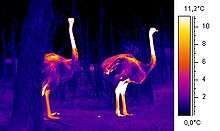Thermolabile
Thermolabile refers to a substance which is subject to destruction, decomposition, or change in response to heat. This term is often used to describe biochemical substances.[1]
| Thermoregulation in animals |
|---|
 |
For example, many bacterial exotoxins are thermolabile and can be easily inactivated by the application of moderate heat. Enzymes are also thermolabile and lose their activity when the temperature rises. Loss of activity in such toxins and enzymes is likely due to change in the three-dimensional structure of the toxin protein during exposure to heat. In pharmaceutical compounds, heat generated during grinding may lead to degradation of thermolabile compounds.
This is of particular use in testing gene function.[2] This is done by intentionally creating mutants which are thermolabile. Growth below the permissive temperature allows normal protein function, while increasing the temperature above the permissive temperature ablates activity, likely by denaturing the protein.
Thermolabile enzymes are also studied for their applications in DNA replication techniques, such as PCR, where thermostable enzymes are necessary for proper DNA replication. Enzyme function at higher temperatures may be enhanced with trehalose, which opens up the possibility of using normally thermolabile enzymes in DNA replication.[3]
References
- "Thermolabile". web.csulb.edu. Retrieved 2018-12-07.
- Tan, G; Chen, M; Foote, C; Tan, C (September 2009). "Temperature-sensitive mutations made easy: generating conditional mutations by using temperature-sensitive inteins that function within different temperature ranges". Genetics. 183 (1): 13–22. doi:10.1534/genetics.109.104794. PMC 2746138. PMID 19596904.
- CARNINCI, PIERO; et al. (January 1998). "Thermostabilization and thermoactivation of thermolabile enzymes by trehalose and its application for the synthesis of full length cDNA" (PDF). Proceedings of the National Academy of Sciences. 95: 520–524. doi:10.1073/pnas.95.2.520. PMC 18452. PMID 9435224.